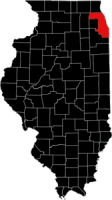Cook County

Location of Cook County in Illinois.

Location of Cook County in Illinois.
Until the beginning of the twentieth century, animal specimens were traditionally preserved as study skins or as crudely stuffed mounts. Then, in the early 1910s, a man named Carl Akeley pioneered new specimen preparation techniques that enabled him to create more realistic displays. The Chicago Academy of Sciences also began to experiment with these ideas and devised large, meticulously-detailed dioramas as a new way to represent local species and natural areas.
Frank Woodruff, an ornithologist, curator, and director at the Academy from 1896 to 1926, oversaw the development of the Chicago Environs Series, a group of exhibits that presented natural areas around Chicago. His first life-size diorama depicting the dunes ecosystem and the Calumet River used photographs that were enlarged up to 11 feet high by 10 feet wide for the backdrops. In this image from a glass plate negative, Woodruff (in suspenders) and other Academy staff process one of these diorama backdrops.
Woodruff was instrumental in the development and expansion of dioramas at the Academy’s Laflin Building. Development of dioramas and experimentation with how to present nature in its truest form to museum visitors began in earnest starting in the very early 1900s. Woodruff developed a new process to create backdrops for dioramas by enlarging photographic negatives. Using these methods led to the development of the Chicago Environs Series.